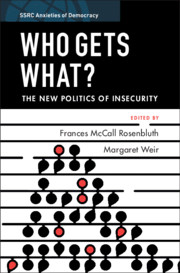Book contents
- Who Gets What?
- SSRC Anxieties of Democracy
- Sponsored by the Social Science Research Council
- Who Gets What?
- Copyright page
- Contents
- Figures
- Tables
- Author Biographies
- Acknowledgments
- 1 Introduction
- Part I People
- Part II Places
- Part III Politics
- 9 Electoral Realignments in the Atlantic World
- 10 Political Parties in the New Politics of Insecurity
- 11 The Peculiar Politics of American Insecurity
- 12 The Anxiety of Precarity
- 13 Increasing Instability and Uncertainty among American Workers
- Index
- References
13 - Increasing Instability and Uncertainty among American Workers
Implications for Inequality and Potential Policy Solutions
from Part III - Politics
Published online by Cambridge University Press: 20 August 2021
- Who Gets What?
- SSRC Anxieties of Democracy
- Sponsored by the Social Science Research Council
- Who Gets What?
- Copyright page
- Contents
- Figures
- Tables
- Author Biographies
- Acknowledgments
- 1 Introduction
- Part I People
- Part II Places
- Part III Politics
- 9 Electoral Realignments in the Atlantic World
- 10 Political Parties in the New Politics of Insecurity
- 11 The Peculiar Politics of American Insecurity
- 12 The Anxiety of Precarity
- 13 Increasing Instability and Uncertainty among American Workers
- Index
- References
Summary
In this chapter, we identify how recent trends combine to increase instability and uncertainty among low-wage workers, discuss the effects of instability and uncertainty on workers and families, and consider potential policy solutions. Several trends in demographics and in the US labor market have combined to increase instability and uncertainty among low-wage workers since the 1970s: first, the long-run move of low-skilled employment demand toward the service sector, which is lower paying and less stable than manufacturing; second, the related rise of both dual-earner and single-headed households, which has led to an increase in caregiver-breadwinners, or workers who are their family’s primary care provider as well as the primary or sole income earner; third, the growth of the elderly population in the context of our societal dependence on informal caregiving; and fourth, decreasing schedule and earnings stability within service employment, which increases income volatility and decreases family well-being for caregiver-breadwinners. High-skilled workers can address these challenges through paid help, insurance, and other forms of consumption smoothing, while the increasing stress on low-skilled workers represents another, insidious form of inequality. We demonstrate how all these forms of instability can inhibit children’s human capital development, transmitting this inequality to future generations. Finally, we identify and evaluate the evidence regarding a number of policy solutions, including schedule stability legislation, universal care supports, and paid family leave, aimed at alleviating strain on low-skilled workers, particularly the growing group of such workers who combine caregiving and breadwinning, and highlight the legislative pathways for positive policy change.
- Type
- Chapter
- Information
- Who Gets What?The New Politics of Insecurity, pp. 307 - 328Publisher: Cambridge University PressPrint publication year: 2021
References
- 1
- Cited by



